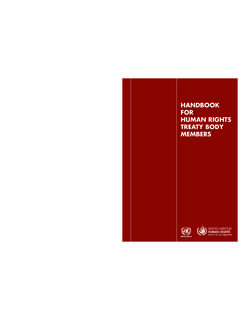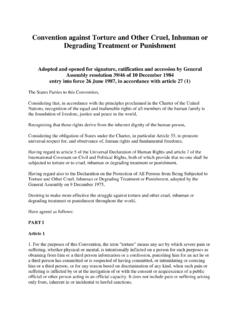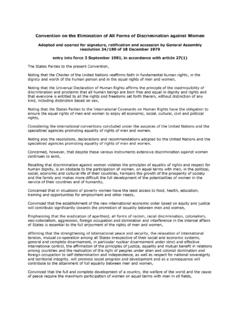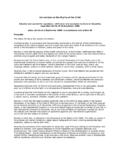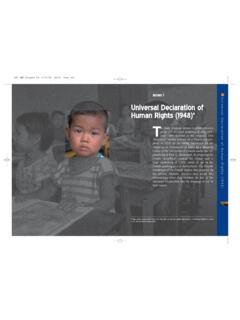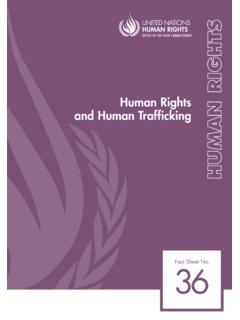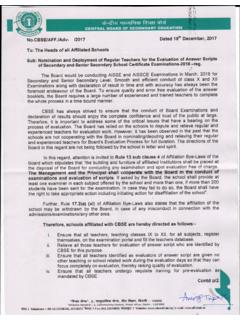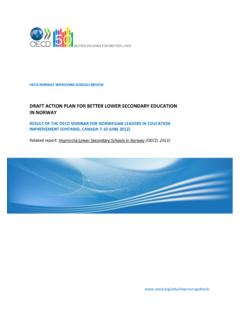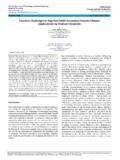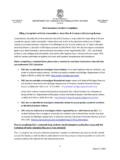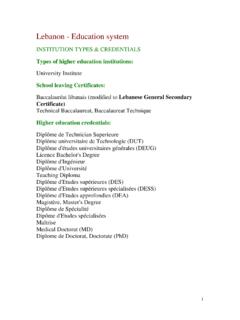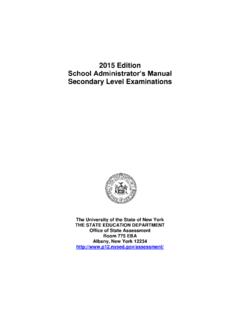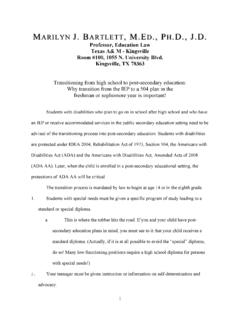Transcription of Human Rights Education in Primary and Secondary …
1 Human Rights Education in Primary and Secondary School Systems: A self - assessment guide for Governments New York and Geneva, 2012 NOTE The designations employed and the presentation of the material in this publication do not imply the expression of any opinion whatsoever on the part of the Secretariat of the United Nations concerning the legal status of any country, territory, city or area, or of its authorities, or concerning the delimitation of its frontiers or boundaries. * * * Symbols of United Nations documents are composed of capital letters combined with figures. Mention of such a figure indicates a reference to a United Nations document. 2012 United Nations All worldwide Rights reserved HR/PUB/12/8 iii PREFACE The international community has on many occasions most recently, with the adoption of the United Nations Declaration on Human Rights Education and Training on 19 December 2011 expressed its consensus on the importance of Human Rights Education as a process that builds knowledge, skills and attitudes prompting behaviour that upholds Human Rights .
2 In this sense, Human Rights Education makes an essential contribution to the protection of Human Rights and supports communities and societies where the Human Rights of all are valued and respected. This publication aims at assisting national authorities responsible for the school system with practical guidance to integrate Human Rights Education in Primary and Secondary Education . In particular, it will help them to assess where they stand, what they have accomplished so far and what areas need further attention. The initial concept of this guide was developed in the context of the Inter-Agency Coordinating Committee on Human Rights Education in the School System, a group of representatives of 12 United Nations entities that worked together, from 2007 to 2010, to contribute to a coordinated and coherent United Nations approach to strengthening national capacities in this area, increasing cooperation among international actors and promoting a sustained political commitment to Human Rights Education , including follow-up within the framework of the World Programme for Human Rights Education (2005 ongoing).
3 The Office of the United Nations High Commissioner for Human Rights (OHCHR) and the United Nations Educational, Scientific and Cultural Organization (UNESCO), both members of the Committee, took up this project and brought it to completion. The guide builds on the Plan of Action for the first phase (2005 2009) of the World Programme for Human Rights Education , developed by experts and practitioners in Human Rights Education in Primary and Secondary schools. While the first phase ended in 2009, numerous challenges remain and the World Programme, therefore, encourages Member States to continue their efforts to implement Human Rights Education in Primary and Secondary school systems. The development of this guide has also benefited from the expert input of EQUITAS - International Centre for Human Rights Education and from the review by various practitioners.
4 OHCHR and UNESCO hope that this self - assessment guide will help Member States to increase teaching and learning about Human Rights throughout Primary and Secondary Education , as a key component of achieving quality Education for all. iv Contents Page iii Introduction .. 1 I. THE INITIAL SITUATION ANALYSIS OF Human Rights Education .. 7 A. What is a situation analysis? .. 7 B. How to carry out a situation analysis .. 8 C. Where to go from here? .. 11 II. self - assessment OF THE IMPLEMENTATION OF A Human Rights Education STRATEGY .. 12 A. Planning for Human Rights Education self - assessment : a detailed work plan .. 12 B. Issues and questions for Human Rights Education 21 III. ONLINE EVALUATION RESOURCES FOR Human Rights Education .. 38 A. United Nations documents and resources.
5 38 B. General educational evaluation resources .. 38 C. Education policies .. 40 D. Policy implementation .. 41 E. The learning environment .. 41 F. Teaching and learning processes and tools .. 42 G. Education and professional development of teachers and other educational personnel .. 44 1 Defining Human Rights Education and a Human Rights -based approach to Education Based on international Human Rights instruments, Human Rights Education (HRE) can be defined as Education , training and information aimed at building a universal culture of Human Rights through the sharing of knowledge, imparting of skills and moulding of attitudes to prompt action directed at strengthening respect for Human Rights , fundamental freedoms, tolerance, equality and peace, among individuals, within societies and among nations.
6 Such Education requires the adoption of a Human Rights -based approach to Education , which promotes both Human Rights through Education , ensuring that all the components and processes of Education including curricula, materials, methods and training are conducive to the learning of Human Rights , and Human Rights in Education , ensuring that the Human Rights of all members of the school community are respected and Human Rights are practised within the Education system. See Plan of Action for the first phase (2005-2009) of the World Programme for Human Rights Education , paras. 3, 4 and 17. Introduction Why promote Human Rights Education in the school system? The international community has increasingly expressed consensus on the crucial contribution of Human Rights Education (HRE) to the realization of Human Rights as well as to the long-term prevention of Human Rights abuses and violent conflicts.
7 Provisions on HRE, and in particular within the school system, have been incorporated into many international instruments, including the Universal Declaration on Human Rights , the International Covenant on Economic, Social and Cultural Rights , the Convention on the Rights of the Child, the Convention on the Elimination of All Forms of Discrimination against Women, the UNESCO Convention against Discrimination in Education , and the Vienna Declaration and Programme of In the school system HRE is an important component of the right to Education , as it enables the Education system to fulfil its fundamental aims of promoting the full development of the Human personality and appreciation of Human dignity, of strengthening respect for Human rights2 and of delivering a quality Education for all. In this sense, HRE contributes to improving the effectiveness of the Education system as a whole, which in turn contributes to a country s economic, social and political development by providing: 1 For a more comprehensive list, see the Plan of Action for the first phase (2005 2009) of the World Programme for Human Rights Education , paras.
8 10 14. Available from 2 See Committee on the Rights of the Child, general comment No. 1 (2001) on the aims of Education . 2 Improved quality of learning achievements by promoting child-centred and participatory teaching and learning practices and processes, as well as a new role for the teaching profession; Increased access to and participation in schooling by creating a Human Rights -based learning environment that is inclusive and welcoming and fosters universal values, equal opportunities, respect for diversity and non-discrimination; A contribution to social cohesion and conflict prevention by supporting the social and emotional development of the child and by introducing democratic citizenship and The World Programme for Human Rights Education In 2004, the international community launched the World Programme for Human Rights Education (2005 ongoing) to advance the implementation of HRE programmes in all sectors and as a follow-up to the United Nations Decade for Human Rights Education (1995 2004), and decided to focus its first phase (2005 2009) on the integration of HRE in the Primary and Secondary school systems.
9 A related plan of action was adopted in 2005 by the United Nations General Assembly. The Plan of Action encouraged Member States to follow a four-stage process to integrate HRE in the school system: Stage 1: Analysing the current situation of HRE in the school system (Plan of Action, para. 26, stage 1) Actions Address the question: Where are we? Collect information on and analyse the following: Current situation of the Primary and Secondary school system, including the situation of Human Rights in schools; Historical and cultural backgrounds that may influence HRE in the school system; HRE initiatives, if any, in Primary and Secondary school systems; Achievements and shortcomings of and obstacles to initiatives undertaken within the United Nations Decade for Human Rights Education , 1995 2004; Involvement of various actors, such as governmental institutions, national Human Rights institutions, universities, research institutes and non-governmental organizations, in HRE in the school system; Good HRE practice existing at national and regional levels.
10 Role of similar types of Education ( Education for sustainable development, peace Education , global Education , multicultural Education , citizenship and values Education ) that may exist in the country. Determine which measures and components of HRE exist already, based on the reference tool provided in the appendix [to the Plan of Action]. Other elements for the analysis would be the national reports to the United Nations treaty bodies, as well as reports produced within the 3 See Plan of Action, para. 19. 3 framework of the Decade at national and international levels. Identify key features and areas by analysing and determining advantages, disadvantages, as well as opportunities for and limitations to HRE in the school system. Draw conclusions on the state of existence and implementation of HRE.
